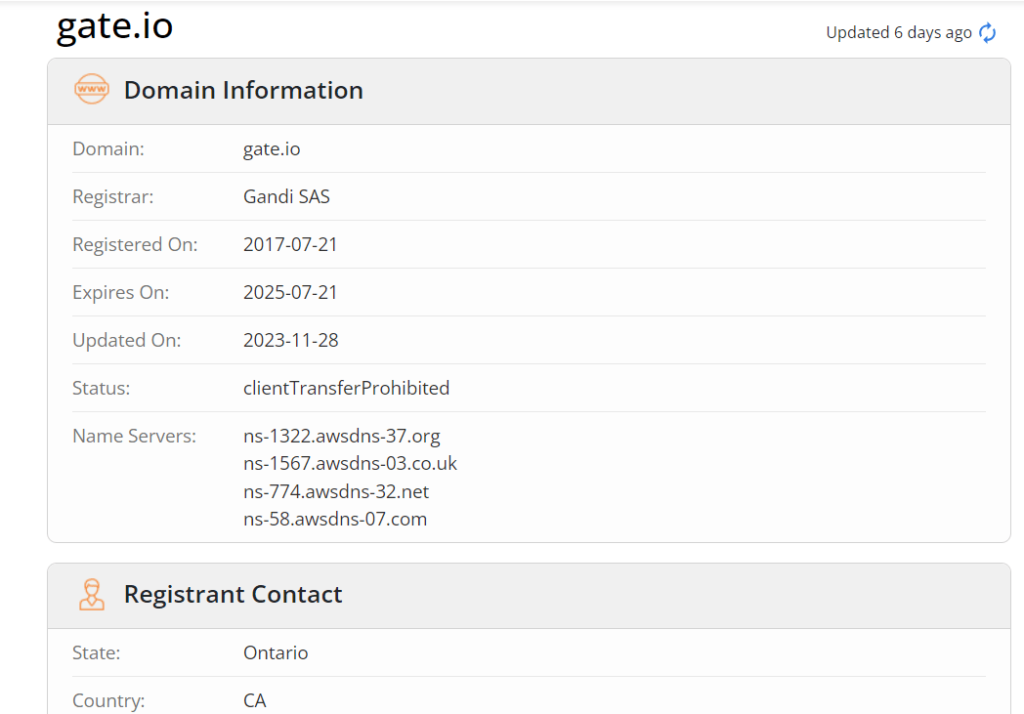You’ve found what seems to be the perfect crypto site, with tempting offers and promises of high returns. But just before you click “Sign Up,” doubts start.
Is this too good to be true? You’re not alone in this worry.
In 2023, crypto scams caused global losses of over $3 billion, with fake crypto sites being a major issue. As the crypto market grows, so does the number of scammers trying to trick newcomers.
If you’re new to cryptocurrency, it’s crucial to learn how to know if a crypto site is legit or fake before you invest your money.
This guide will show you the key signs to watch for when evaluating a crypto site. This way, you can make informed decisions and protect your funds.
How to Know if a Crypto Site is Legit or Fake
Follow this simple guide to find out if a crypto site is legit or fake.
1. Check the Domain Age and Registration
To determine if a crypto site is legit or fake, start by checking the domain’s age and registration details. The age of the domain shows how long the website has been active, which can help assess its reliability.
Generally, older domains are more trustworthy because they’ve had time to establish a market presence. Scammers, however, often create new domains to quickly launch scam sites that they abandon after deceiving a few users.
Websites that have been active for several years are usually less likely to be fake crypto sites.
You can verify a domain’s age and registration information using tools like Whois or DomainTools. These tools let you see when the domain was registered, who owns it, and when it expires.
If the domain is only a few months old or the registration details are hidden by privacy services, this could be a red flag.
Below, you’ll find the Whois data for Gate.io, one of the most trusted crypto exchanges, to help you understand what to look for.

Read Also: A Guide to Choosing the Right Crypto Exchange for You
2. Check the URL Carefully
Scammers often use subtle tricks to mislead users, with one of the most effective being the creation of fake crypto websites that closely mimic legitimate URLs.
These fake sites usually have only minor differences, such as an extra letter, a different domain extension (like .net instead of .com), or the substitution of similar-looking characters (like “1” instead of “l” or “0” instead of “O”). They may also include hyphens. These small changes can be easily overlooked, especially when you’re in a hurry or not paying close attention.
This technique can deceive even the most careful users if they’re not fully alert.
To ensure you’re on a genuine crypto site, always double-check the URL before interacting with the website. This is especially important if you arrive at the site through an email link, social media, or a recommendation from someone you’ve met online.
3. Evaluate the Site’s Traffic and Popularity
Another effective way to determine if a cryptocurrency site is legit or fake is by analyzing its traffic and popularity. A site with many visitors is usually trusted by many users, while low traffic might suggest the site is suspicious.
Reputable crypto sites often attract a lot of traffic, which reflects their good reputation and reliability. On the other hand, scam sites tend to have low traffic because they are often abandoned once their fraud is exposed.
To check a site’s traffic and popularity, you can use various tools, with SimilarWeb.com being a top choice.
SimilarWeb provides detailed information about a website’s traffic, such as the total number of visits, average time spent on the site, and traffic sources. This data helps you understand the site’s user base.
A trustworthy website usually shows a consistent flow of visitors over time, which signals its reliability.
Below is traffic data for Binance, the largest cryptocurrency exchange by trading volume.

4. Look for HTTPS and SSL Certificates
One of the first steps to verify if a crypto site is legitimate is to check if it uses HTTPS and has a valid SSL certificate.
HTTPS (Hypertext Transfer Protocol Secure) and SSL (Secure Sockets Layer) certificates are essential for securing data exchanged between your browser and the website. These security measures encrypt sensitive information, like your login credentials and payment details, protecting them from hackers.
If a website doesn’t use HTTPS or has an invalid SSL certificate, it may not be safe.
To check for HTTPS and SSL certificates, look at the website’s URL. A secure site’s URL starts with “https://” instead of “http://”. The “s” stands for SSL encryption.
Most modern browsers make this easy by showing a padlock icon in the address bar when the site has a valid SSL certificate. Clicking on this icon will give you more details about the certificate.
Also, pay attention if your browser warns you about an invalid certificate or an insecure connection. In these cases, it’s best to proceed with caution or avoid the website entirely.
However, remember that while HTTPS is a basic security feature for any legitimate site, it doesn’t guarantee the site’s authenticity. Some fraudulent sites also use SSL certificates, so consider other factors when evaluating if a crypto site is legit or fake.
5. Analyze Payment Methods
The payment options on a crypto site can reveal a lot about its legitimacy.
Trustworthy cryptocurrency websites usually offer several payment methods, such as credit and debit cards, bank transfers, and popular payment services. These options provide added security and allow for charge disputes if problems occur.
On the other hand, fraudulent sites often prefer payment methods that are hard to reverse, like direct cryptocurrency transactions. This makes it almost impossible to get your money back once it’s transferred.
Therefore, it’s vital to carefully check the available payment methods before making any transactions on a crypto site.
Be cautious if the site only accepts cryptocurrency deposits.
A reliable crypto platform should offer a variety of payment options.
6. Check for a Physical Address and Contact Information
A trustworthy crypto site should clearly display accessible contact details, including a physical address. This transparency is a key sign of the platform’s integrity and its willingness to be held accountable.
Why does this matter? Scam platforms often hide behind vague or missing contact information.
Without a verifiable physical address or reliable contact details, it can be almost impossible to reach the platform’s operators if issues arise. On the other hand, a legitimate site will typically provide multiple contact options, such as a physical address, phone number, and email.
To check a site’s authenticity, look for a physical address. Trustworthy sites usually list this information on their “Contact Us” or “About Us” pages. You should be able to verify the address with a quick online search or mapping service.
Also, review the provided contact information. Real businesses usually offer several ways to reach them, like customer support email, phone number, or live chat. Make sure these methods work and aren’t just placeholders.
If you’re unsure, try reaching out using the contact methods provided. A quick and professional response can indicate the site’s legitimacy.
If the address is incomplete or the contact details don’t work, consider it a warning sign.
7. Cross-Check the Information
When using online crypto platforms, it’s crucial to be careful and not trust everything you see. Verifying the information on a crypto site is key to determining if it’s legit or fake.
Start by checking for consistency across the website. Scammers often copy content from other sites, leading to noticeable inconsistencies. Review different sections like the terms and conditions, privacy policy, and FAQ pages to ensure the information aligns. Any discrepancies could suggest the site is misleading or not as professional as it claims.
Also, if the website mentions partnerships or endorsements, verify these claims through reliable sources. Visit the official websites of the companies or celebrities they mention to see if they confirm the partnership. If you can’t find any evidence, the claims might be false.
Lastly, search for the site’s name on trusted crypto news websites. A legitimate platform is likely to be covered by industry news, while a scam site may have little or no presence beyond its own domain.
8. Verify Social Media Presence
A strong, active social media presence is often a sign of a trustworthy cryptocurrency site. On the other hand, scam sites usually have little to no social media activity.
By checking a site’s social media activity, you can gauge its legitimacy and see how it interacts with its audience. Red flags like inactivity, low engagement, or a large number of fake followers may indicate that the site is not reliable.
So, how can you tell if a crypto site’s social media is legit or fake?
A credible crypto site will link to its social media accounts directly on its website, and these accounts should have verification badges on platforms like Twitter, Instagram, and Facebook.
These profiles should be regularly updated with quality posts.
Be wary of accounts with a high number of followers but low engagement, as this could be a sign that the site is not trustworthy.
9. Inspect the User Reviews
User reviews are a useful tool for checking the credibility of a crypto site. By reading these reviews, you can learn about other users’ experiences and decide if the site is trustworthy.
Positive feedback usually means the website is legit. However, if you see many negative reviews or repeated complaints, it could signal problems or potential scams.
For a thorough review, check feedback on various platforms. Look at popular review sites, cryptocurrency forums, and social media. Websites like Trustpilot, Reddit, and crypto review sites offer a wide range of opinions.
Be wary of fake reviews. Reviews that are overly positive, lack details, or appear in large numbers quickly might be fake. These reviews often use similar language and tone, which can be a red flag.
Single negative comments might not be serious, but if you see consistent reports of issues like withdrawal problems, poor customer service, or broken promises, take them seriously as potential warning signs.
Read Also: Most Common Crypto Scams and How to Avoid Them
10. Check for Proper Grammar and Spelling
The quality of a website’s content, especially its grammar and spelling, is a key indicator of credibility.
Trusted crypto sites understand the importance of clear communication and often invest in producing well-written, polished content. On the other hand, fake sites usually overlook this, leading to text filled with grammatical errors, spelling mistakes, and other careless issues.
When evaluating a site’s content quality, carefully examine the text. Pay attention to grammar, spelling, and overall clarity.
A reliable crypto site will have content free of obvious grammar or spelling errors. They will also focus on details like punctuation, capitalization, and formatting, ensuring a professional look.
Additional Resources:
- Ways to Secure Your Cryptocurrency: Best Practices for Beginners
- How to Research a Crypto Project Properly Before Investing
- How to Report a Bitcoin Scam
And guess what? We’re also on Instagram and Twitter(X). Join us there for even more fun and useful content!

DISCLAIMER:
The information provided here is for informational purposes only. Do not rely solely on it for making investment decisions. It is not financial, tax, legal, or accounting advice. Always do your own research or consult a financial advisor before investing in cryptocurrency.
